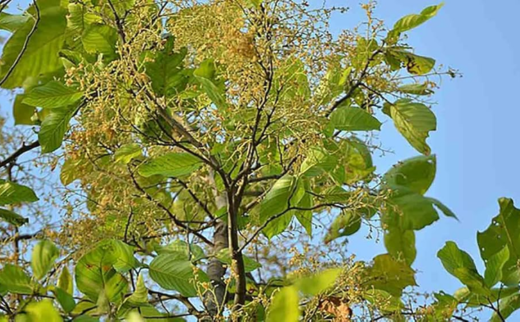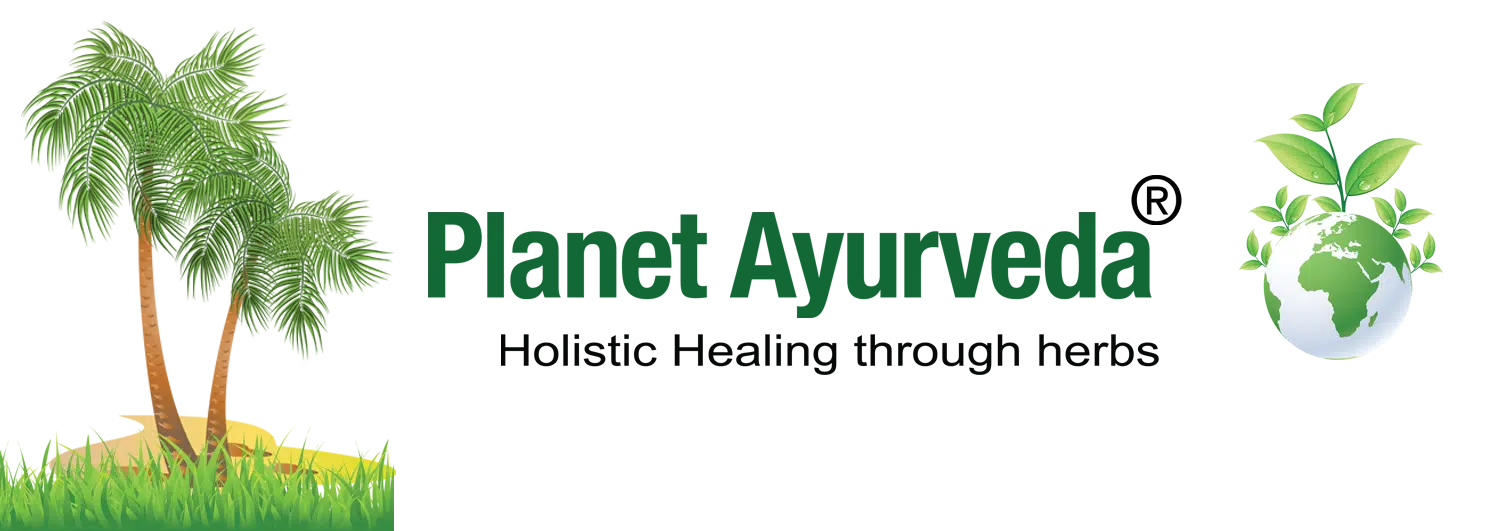Shaal/ The Sal Tree/ Shorea robusta Gaertn. F. – Ayurvedic Uses, Benefits, Dosage & Therapeutic Actions
Abstract
Shorea robusta Gaertn. f., commonly referred to as Sal, Shala, Indian Dammer, or the Holy Tree, is an indigenous and culturally revered plant with wide-ranging medicinal applications. In Ayurveda, its bark and leaves have traditionally been used to treat numerous ailments such as itching, leprosy, gonorrhea, wounds, stomach ulcers, vaginal disorders, cough, earaches, and headaches. It is also valued for its actions as an anthelmintic, blood purifier, complexion enhancer, sweat suppressant, and general detoxifier (alexeteric). In the Unani system of medicine, S. robusta is used to manage menorrhagia, soothe eye irritations, and treat splenic enlargement.

Introduction
Shorea robusta is a large forest tree belonging to the Dipterocarpaceae family and is primarily found in India, Nepal, and Bangladesh. Phytochemically, the plant is a rich source of primary and secondary metabolites, making it highly pharmacologically active. Important bioactive compounds isolated from Shorea robusta include bergenin, ursolic acid, lupeol, β-caryophyllene, α- and β-amyrin, caryophyllene oxide, calarene epoxide, and β-humulene. Scientific studies conducted on experimental animals have confirmed its broad range of therapeutic effects, such as analgesic, anti-inflammatory, anticancer, antiulcer, antipyretic, antimicrobial, anticonvulsant, antidiabetic, antihyperlipidemic, antioxidant, immunomodulatory, and wound-healing activities. This makes Shorea robusta a valuable plant-based remedy with multi-therapeutic potential, capable of addressing a diverse spectrum of health issues in both traditional and modern medicinal systems.
Scientific Classification
- Kingdom: Plantae
- Division: Magnoliophyta
- Class: Magnoliopsida
- Order: Malvales
- Family: Dipterocarpaceae
- Genus: Shorea
- Species: Shorea robusta Gaertn. f.
Synonyms
- Ashwakarna – The leaves of Shorea robusta are shaped like a horse’s ear.
- Dhupavriksha – The tree is valued for its resin, which is commonly used in fumigation.
- Rala – The resin, when burned, creates a pleasant and calming aroma.
- Kanakalodhbava, Kalyana, Kanta, Rala Niryasa, Vrischikara, Shalaniryasa, Sarjaniryasa, Surabhi, Sarjarasa – Traditional Sanskrit synonyms highlighting its resin, fragrance, and auspicious nature.
- Maricha Patraka – The leaves bear a resemblance to those of the black pepper plant (Maricha).
- Sura Dhoopa, Yaksha Dhoopa – Names reflecting the use of its aromatic resin in incense offerings, known for its divine fragrance.
- Agnivallabha – Indicates that the resin is highly flammable and ignites easily, making it ideal for rituals involving fire.
Vernacular Names
- English: Sal Tree, Common Sal, Indian Dammer, Cannonball Tree
- Hindi: Sakher, Sakhu, Sal, Shal
- Bengali: Skaher, Skahua, Sal
- Gujarati: Ral
- Marathi: Rala, Sajara
- Oriya (Odia): Sagua, Salo, Sarjjo, Salwa, Sekwa
- Punjabi: Sal, Seral
- Tamil: Attam, Kungiliyam, Shalam, Talur
- Telugu: Gugilamu, Sarjamu
- Urdu: Raal
- Assamese: Sal
- Nepali: Agrakh, Sakhua, Sakwa, Sal
- Russian: Sal, Salovoe Derevo, Shoreia Moshchnaia
- German: Salbaum, Salharzbaum
- French: Damar de l’Inde, Arbre à Sal, Balau Jaune
- Chinese: Suo Luo Shuang, Suo Luo Shuang Shu
- Japanese: Sara Noki, Serangan Batsuu, Shara Noki
Habitat
Shorea robusta is extensively found across India, Nepal, and Bhutan. In India, its distribution ranges from Himachal Pradesh in the north to the northeastern states such as Assam, Tripura, and West Bengal, as well as Bihar and Odisha. It also grows in the eastern regions of Madhya Pradesh and extends into the Eastern Ghats of Andhra Pradesh. The species is commonly seen in the plains, lower Himalayan foothills, and along river valleys.
Morphology
Shorea robusta is a large deciduous tree, typically reaching heights of 20 to 30 meters, and is rarely completely leafless. Its leaves are simple, alternate, and entire, measuring about 10–30 cm in length and 5–18 cm in width. They are ovate-oblong in shape with a pointed (acuminate) tip, tough and leathery (coriaceous), smooth (glabrous), and shiny when mature, with a rounded or heart-shaped base and 12–15 pairs of lateral veins. The petiole is 1.2–2 cm long, and the stipules are about 7.5 mm in length. The flowers are small, around 1.2 cm long, and are whitish to cream-yellow in colour. They appear in axillary or terminal racemose panicles ranging from 10 to 23 cm long, with greyish, tomentose branches. Each flower has 5–6 twisted lobes forming the calyx with a short tube, a corolla of 5 petals, and 15 stamens arranged in three rows. The ovary is three-celled with a slender (subulate) style and a stigma that is either entire or slightly lobed. The fruit is an indehiscent, ovoid nut about 1.2 cm long with five prominent, wing-like calyx lobes. These wings are somewhat unequal, oblong or spathulate in shape, measuring 5–7.5 cm in length, with 10–15 longitudinal veins connected by straight or oblique transverse veins, and are reddish to pale yellowish-green in colour. The seed is a one-seeded nut, ovoid in shape, containing fleshy, unequal cotyledons. The bark of the tree is dark brown and may be smooth or marked with a few longitudinal cracks.
Controversies
There exists some botanical and Ayurvedic controversy regarding the nomenclature and classification of resin-yielding trees, particularly in relation to Shorea robusta and similar species. The term Shala is primarily associated with Shorea robusta, while Sarja generally refers to the Copal tree, Vateria indica, which also produces a medicinal resin. Additionally, Ashwakarna is identified with Dipterocarpus alatus, and Ajakarna with Shorea tumbuggaia—both of which are known to yield aromatic and therapeutic resins. Although all these species are resin-producing members of the Dipterocarpaceae family, Ayurvedic texts often distinguish between them. Specifically, terms like Shala, Rala, and Shala Niryasa typically denote the resin obtained from Shorea robusta, whereas Sarja, Sarjarasa, and Sarja Niryasa are more accurately used to describe the resin derived from Vateria indica.
Special Note
The gum of the Sal tree is called Raal (resin). It is white with a yellowish tinge with a little blackish tinge. In its new state, it is colourless and transparent. It mixes with oil and burns easily.
The word Sarjaras has been used in Charak and Sushruta for resin. The word Shalaniryas is not seen in Charak Sushruta. Vaidyas use Sal resin as resin which mostly comes from Singapore. The resin used in medicine, which is called Rajan (Rejhin), is the residue left after extracting tarpeena oil from Gandhabiroja. The description of the Sal (Sakhu) tree has been given further in the Vatadi Varga. The Sarja tree (Shaal Bhed) and the resin obtained from it, which is called Chandrasa, have also been described in the Vatadi Varga.
Classical Categorisation
- According to Charaka Samhita – Vedanasthapana (pain-relieving group), Kashaya Skanda (astringent group of herbs)
- According to Sushruta Samhita – Salasaradi Gana, Rodhradi Gana
- According to Bhavaprakash Nighantu – Vatadi Varga
- According to Ashtanga Sangraha – Asanadi Gana, Rodhradi Gana, Vedanasthapana
- According to Ashtanga Hridaya – Asanadi Gana, Rodhradi Gana
- According to Raj Nighantu – Chandanadi Varga
- According to Dhanvantari Nighantu – Chandanadi Varga
- According to Kaiyadeva Nighantu – Aushadhi Varga
Ancient Verses
शालस्तु सर्जकार्याश्वकर्णकाः शस्यशम्बरः ।
अश्वकर्णः कषायः स्याद् व्रणस्वेदकफक्रिमीन् ।।
ब्रध्नविद्रधिबाधिर्ययोनिकर्णगदान् हरेत् ॥
(Bhavprakash Nighantu Vatadi varga 19)
According to the above shloka, the Sanskrit names of Sakhu are Shaal, Sarj, Karthya, Ashvakarnak and Shasyashambar. It has an astringent taste and is effective in the management of Wounds, sweating, phlegm, worm infestation, abscess, deafness, vaginal and ear diseases.
रालस्तु शालनिर्यासस्तथा सर्जरसः स्मृतः । देवधूपो यक्षधूपस्तथा सर्वरसश्च सः ॥४८॥ रालो हिमो गुरुस्तिक्तः
कषायो ग्राहको हरेत् । दोषास्त्रस्वेदवीसर्पज्वरव्रणविपादिकाः ।।
ग्रहभग्नाग्निदग्धांश्च शूलातीसारनाशनः ॥४९॥
According to the above shloka, the other names of Raal are salaniryasa, sarjarasa, devadhup, yakshadup and sarvarasa. Raal has cold potency, heavy in nature, bitter and astringent taste and absorbent in nature. It is effective in the management of bleeding disorders, sweat, erysipelas, fever, wounds, skin problems, etc. It is also effective in the management of fractures, burns, pain and diarrhoea.
Ayurvedic Properties
- Taste (Rasa) – Astringent (Kashaya)
- Physical property (Guna) – Dry (Rooksha)
- Potency (Veerya) – Cold Potency (Sheet)
- Post-digestion effect (Vipaka) – Katu (Pungent)
- Effect on Tridosha – Balance Vata and Kapha dosha
Raal
- Taste (Rasa) – Bitter (Tikta), Astringent (Kashaya)
- Physical property (Guna) – Heavy (Guru)
- Potency (Veerya) – Cold Potency (Usna)
Therapeutic Properties of the Saal Tree
- Stimulant – Enhances physiological functions
- Expectorant – Helps in expelling mucus from the respiratory tract
- Diuretic – Promotes urine formation and detoxification
- Styptic – Stops bleeding, both internally and externally
- Medohara – Helps in reducing excess fat (anti-obesity)
- Vrana Shodhana – Cleanses wounds and ulcers
- Vranaropana – Promotes wound healing
- Grahi – Absorbent; useful in treating diarrhoea and dysentery
- Vishaghna – Detoxifies poisons and neutralises toxins
- Vedana Sthapana – Acts as an analgesic or pain reliever
- Stambhana – Stops abnormal discharges such as diarrhoea or bleeding
- Krimighna – Destroys intestinal worms and parasites
Therapeutic Properties of the Resin of the Saal Tree
- Blood disorders – Helpful in purifying blood and correcting vitiated doshas.
- Excess sweating – Reduces sweda (sweating) by balancing pitta and kapha.
- Visarpa (Herpes / Erysipelas) – Useful in inflammatory and infectious skin conditions.
- Vrana (Wounds) – Cleanses wounds and accelerates the healing process.
- Vipadika (Cracks in palms/soles) – Relieves pain and aids skin repair.
- Graha (Psychiatric disorders) – Beneficial in calming the mind and balancing Vata.
- Bhagna (Fractures) – Promotes bone healing and tissue repair.
- Agnidagda (Burn wounds) – Soothes burns and supports faster healing.
- Jwara (Fever) – Helps reduce temperature and balances aggravated doshas.
- Cough & Asthma – Acts as an expectorant, relieves breathlessness and congestion.
- Shoola (Abdominal colic) – Provides relief from pain and cramps.
- Atisara (Diarrhoea) – Controls excess watery stools and restores gut balance.
- Kandu (Itching) – Relieves irritation and allergic skin manifestations.
- Sphota (Blisters) – Useful in vesicular eruptions and inflammation.
- Bleeding haemorrhoids – Helps arrest bleeding and heals fissures/haemorrhoids.
Systemic Actions
External Uses
Shala possesses analgesic, antimicrobial, wound-cleansing, and healing properties. It promotes fracture healing and is beneficial in various skin disorders such as dadru (ringworm), boils, cracked heels, and burns. Both bark and resin are useful in managing painful inflammatory conditions. It is also suitable for fumigation purposes. In cases of ear infections, decoction of the bark is recommended for external use.
Internal Uses
Nervous System
Exhibits analgesic activity. The decoction is effective in relieving body pain caused by trauma, falls, or injuries.
Digestive System
Acts as an absorbent. Useful in conditions like diarrhoea, rectal bleeding, and haemorrhoids.
Circulatory System
Beneficial in managing bleeding disorders and anaemia resulting from excessive blood loss.
Respiratory System
The bark helps pacify Kapha dosha, while the latex assists in expelling aggravated Kapha from the respiratory tract.
Reproductive System
Indicated in conditions such as leukorrhea, menorrhagia, and metrorrhagia. Also effective in managing inflammatory disorders of the uterus and associated reproductive structures.
Excretory System
Reduces urine output, making it beneficial in the management of diabetes. The resin, due to its antimicrobial nature, is useful in urinary tract infections (UTI).
Satmikarana (Rejuvenation)
Supports bone healing in fractures and wound recovery. Also found useful in obesity and related metabolic disorders.
Chemical Composition
Resins
- Oleo-gum resin contains: Hydroxyanone, Dammarenediol II, Ursolic acid
Triterpenoids
- Nor-triterpenes
- Triterpenic acids
- α-Amyrenone
- α- and β-Amyrin
- Ursolic acid
Phenolic Compounds
- Tannic acid
- Bergenin from leaves
- Other phenolic compounds present in oleoresin
Flavonoids
- Leucoanthocyanidin (in seeds)
- 3,7-Dihydroxy-8-methoxyflavone (in seeds)
Fatty Acids
- 9,10-Dihydroxystearic acid (in Sal oil)
- 9,10-Epoxystearic acid (in Sal oil)
Other Constituents (in Leaves)
- Lup-20(29)-en-3-one
- Lupeol
- Beta amyrone
- Squalene
- Stigmasta-5-en-3-ol
- Vitamin E
- n-Hexadecanoic acid
Other Constituents (in Fruits)
- Octadecatrienoic acid
- 4H-Pyran-4-one, 2,3-dihydro-3,5-dihydroxy-6-methyl
- 5-Hydroxymethylfurfural
- 24-Norursa-3,12-diene
- 9,12-Octadecadienoic acid
Heartwood Compound
- Germacrene-D
Modern Overview
Abscess And Wound Healing Activities
Shorea robusta resin plays a significant role in the management of abscesses and wound healing due to its potent astringent, antiseptic, and anti-inflammatory properties. When applied topically, the resin helps in cleansing the wound, reducing microbial load, and promoting tissue regeneration. Ursolic acid and bergenin, isolated from the young leaves, contribute to wound healing by modulating inflammatory mediators and cytokines, thereby reducing inflammation and accelerating the repair process. The presence of tannins aids in contracting tissues and controlling local bleeding, while flavonoids and phenolic acids offer antioxidant protection, preventing further cellular damage. These combined actions help in draining pus, reducing swelling, and facilitating faster closure of abscesses and open wounds. Moreover, the resin forms a protective barrier over the affected area, shielding it from external pathogens and aiding in natural healing.
Anticancer Activity
The methanolic extract of Shorea robusta bark contains triterpenoids α-amyrin and β-amyrin, which have demonstrated potential anticancer activity through molecular docking studies. These compounds showed strong binding affinities with the human oncogene Ras protein (HRas), a key regulator of cell proliferation and survival often mutated in hepatocellular carcinoma. α-Amyrin exhibited a binding energy of -9.36 kcal/mol and β-amyrin -8.90 kcal/mol, indicating strong molecular interactions. Their binding may interfere with the Ras protein’s ability to activate downstream signalling pathways like MAPK/ERK, which are crucial for cancer cell growth and survival. By inhibiting these pathways, α- and β-amyrin could suppress tumour progression and induce apoptosis in cancerous cells. These findings suggest their therapeutic promise as natural anticancer agents targeting liver cancer.
Anti-Arthritic Activities (Of Resin)
Hydroxyanone, dammarenediol II, and ursolic acid present in Shorea robusta contribute significantly to arthritis management. Hydroxyanone acts as a potent antioxidant that reduces oxidative stress in inflamed joints, thereby minimising tissue damage. Dammarenediol II exhibits anti-inflammatory and immunomodulatory properties, which help in suppressing excessive immune responses responsible for joint swelling and pain. Ursolic acid, a triterpenoid, shows strong COX-2 and NF-κB inhibitory actions, reducing the release of pro-inflammatory cytokines and enzymes that degrade cartilage. Together, these compounds protect cartilage, reduce stiffness, and improve joint mobility. Their synergistic action not only provides symptomatic relief from pain and swelling but also slows down the progression of arthritis, making Shorea robusta valuable in long-term joint care.
Practical Uses
Prameha (Urinary Disorders Including Diabetes)
- In Kaphaja Prameha, a decoction prepared using Sala (Shorea robusta), Arjuna (Terminalia arjuna), and Yavani (Trachyspermum ammi), when mixed with honey, is considered highly effective. (Charaka Samhita Chikitsa Sthana 6/27–30)
- The powdered flowers of Sala (Shorea robusta), when combined with honey, are beneficial in managing Prameha. (Charaka Samhita Chi. 6/35; Ashtanga Hridaya Chi. 12/15–16)
- A paste made from Sala (Shorea robusta), Kampillaka (Mallotus philippensis), and Mushkaka (Rhamnus triquetra)—10 grams—mixed with honey, juice of Amalaki (Emblica officinalis), and Haridra (Curcuma longa), is recommended for internal use. (Sushruta Samhita Chi. 11/8)
Hiccough And Asthma
The oleo-gum resin of Sala should be inhaled for relief in hiccough (hikka) and bronchial asthma (shwasa).
Kustha (Skin Disorders)
A medicated ghee preparation made with Priyala (Buchanania lanzan), Sala (Shorea robusta), Aragvadha (Cassia fistula), Nimba (Azadirachta indica), Saptaparna (Alstonia scholaris), Chitraka (Plumbago zeylanica), Maricha (Piper nigrum), Vacha (Acorus calamus), and Kustha (Saussurea lappa) is effective in treating Kapha-dominant skin diseases. (Sushruta Samhita Chi. 9/7)
Galaganda (Goitre)
In goitre caused by excess fat (medas), the heartwood of Sala taken with cow’s urine in the morning is considered beneficial. (Sushruta Samhita Chi. 18/53)
Diseases Of The Mouth
Sala (Shorea robusta) is an ingredient in Snaehika Dhooma, a medicated smoke therapy used in oral and throat conditions. (Sushruta Samhita Chi. 22/69)
Diseases Of The Eye
For eye conditions caused by Kapha and Pitta, a collyrium made with powdered flowers of Kutaja (Holarrhena antidysenterica), Ashoka (Saraca asoca), Sala (Shorea robusta), Amra (Mangifera indica), Priyangu (Callicarpa macrophylla), Lotus (Nelumbo nucifera), and Utpala (Nymphaea stellata), mixed with Renuka (Vitex negundo), Pippali (Piper longum), Haritaki (Terminalia chebula), and Amalaki (Emblica officinalis), along with ghee and honey, and stored in a bamboo tube, should be used as an eye application. (Sushruta Samhita Uttara Tantra 17/8–9)
Diseases Of The Ear
In various ear disorders, juice of Amra (Mangifera indica), Kapittha (Feronia limonia), Madhuka (Madhuca indica), Dhava (Anogeissus latifolia), and Sala (Shorea robusta) or oil processed with these herbs is used as ear drops. (Sushruta Samhita Uttara Tantra 21/47)
Consumption (Rajayakshma / Tuberculosis)
Sala (Shorea robusta) is a key ingredient in the classical Eladi formulation, which is indicated in Rajayakshma (consumption/tuberculosis). (Sushruta Samhita Uttara Tantra 41/50)
Pandu (Anaemia)
In anaemia, the powder of the heartwood of Sala or Amalaki fruit (Emblica officinalis) mixed with honey is advised.
Part Used
- Bark
- Resin
Dosage
- Bark decoction – 50-100 ml
- Resin powder – 1-3 gm
Ayurvedic Medicines
- Salasaradi Kwath
- Sarjarasadi Malahara
- Atasyadi Lepa
Planet Ayurveda Medicines
Conclusion
Shorea robusta, popularly known as the Sal tree, is a valuable medicinal and timber plant found widely across India. It holds a prominent place in Ayurveda due to its astringent, anti-inflammatory, and healing properties. Various parts of the plant, including bark, resin, and flowers, are used in traditional medicine for treating wounds, skin issues, and digestive disorders. The tree is also ecologically important, supporting biodiversity in forest ecosystems. Its historical, medicinal, and cultural significance make it a vital species worth preserving. Promoting its sustainable use can benefit both healthcare and the environment.



